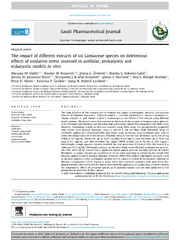Приказ основних података о документу
The impact of different extracts of six Lamiaceae species on deleterious effects of oxidative stress assessed in acellular, prokaryotic and eukaryotic models in vitro
| dc.creator | Oalđe, Mariana M. | |
| dc.creator | Kolarević, Stoimir | |
| dc.creator | Živković, Jelena C. | |
| dc.creator | Vuković-Gačić, Branka S. | |
| dc.creator | Jovanović Marić, Jovana | |
| dc.creator | Kračun-Kolarević, Margareta | |
| dc.creator | Đorđević, Jelena Z. | |
| dc.creator | Alimpić Aradski, Ana Z. | |
| dc.creator | Marin, Petar D. | |
| dc.creator | Šavikin, Katarina P. | |
| dc.creator | Duletić-Laušević, Sonja N. | |
| dc.date.accessioned | 2020-11-19T10:31:52Z | |
| dc.date.available | 2020-11-19T10:31:52Z | |
| dc.date.issued | 2020 | |
| dc.identifier.issn | 1319-0164 | |
| dc.identifier.uri | https://linkinghub.elsevier.com/retrieve/pii/S1319016420302413 | |
| dc.identifier.uri | https://radar.ibiss.bg.ac.rs/handle/123456789/4001 | |
| dc.description.abstract | The main objective of this research was to evaluate the impact of methanolic, ethanolic and aqueous extracts of Origanum majorana L., Origanum vulgare L., Teucrium chamaedrys L., Teucrium montanum L., Thymus serpyllum L. and Thymus vulgaris L. (Lamiaceae) on the effects of free radicals using different model systems. The extracts were characterized on the basis of the contents of total phenolics, phenolic acids, flavonoids and flavonols, and also using high-performance liquid chromatography with diode-array detection. Antioxidant activity in vitro was assessed using DPPH assay. The genoprotective properties were tested using plasmid relaxation assay on pUC19 E. coli XL1-Blue, while SOS/umuC assay on Salmonella typhimurium TA1535/pSK1002 and Comet assay on human lung fibroblasts were used to assess the antigenotoxicity of the extracts. Ethanolic extracts had the most phenolics (up to 236.20 mg GAE/g at 0.5 mg/mL), flavonoids (up to 42.47 mg QE/g at 0.5 mg/mL) and flavonols (up to 16.56 mg QE/g at 0.5 mg/mL), and they exhibited the highest DPPH activity (up to 92.16% at 0.25 mg/mL). Interestingly enough, aqueous extracts provided the best protection of plasmid DNA (the lowest IC50 value was 0.17 mg/mL). Methanolic extracts, on the other hand, most efficiently protected the prokaryotic DNA, while all the extracts had a significant impact against genomic damages inflicted on human fibroblasts. O. vulgare extracts are considered to be the most promising in preserving the overall DNA integrity against oxidative genomic damages. Moreover, HPLC-DAD analysis highlighted rosmarinic acid as the most abundant in the investigated samples (551.45 mg/mL in total in all the extracts), followed by luteolin-7-O-glucoside (150.19 mg/mL in total), while their presence correlates with most of the displayed activities. The novelty of this study is reflected in the application of a prokaryotic model for testing the antigenotoxic effects of Lamiaceae species, as no previous reports have yet been published on the genoprotective potential of these species. | en |
| dc.publisher | Elsevier BV | |
| dc.relation | info:eu-repo/grantAgreement/MESTD/inst-2020/200003/RS// | |
| dc.relation | info:eu-repo/grantAgreement/MESTD/inst-2020/200178/RS// | |
| dc.rights | openAccess | |
| dc.rights.uri | https://creativecommons.org/licenses/by-nc-nd/4.0/ | |
| dc.source | Saudi Pharmaceutical Journal | |
| dc.subject | Lamiaceae | |
| dc.subject | Phenolic components | |
| dc.subject | Antioxidant activity | |
| dc.subject | Cytotoxicity | |
| dc.subject | Antigenotoxicity | |
| dc.subject | Genoprotective effect | |
| dc.title | The impact of different extracts of six Lamiaceae species on deleterious effects of oxidative stress assessed in acellular, prokaryotic and eukaryotic models in vitro | en |
| dc.type | article | en |
| dc.rights.license | BY-NC-ND | |
| dcterms.abstract | Дулетић-Лаушевић, Соња Н.; Оалђе, Мариана М.; Коларевић, Стоимир; Јовановић Марић, Јована; Ђорђевић, Јелена З.; Марин, Петар Д.; Шавикин, Катарина П.; Живковић, Јелена Ц.; Вуковић-Гачић, Бранка С.; Крачун Коларевић, Маргарета; Aлимпић Aрадски, Aна З.; | |
| dc.rights.holder | © 2020 The Author(s) | |
| dc.identifier.doi | 10.1016/j.jsps.2020.10.006 | |
| dc.identifier.scopus | 2-s2.0-85095564994 | |
| dc.identifier.wos | 000605507200011 | |
| dc.citation.apa | Oalđe, M. M., Kolarević, S. M., Živković, J. C., Vuković-Gačić, B. S., Jovanović Marić, J. M., Kračun Kolarević, M. J., et al. (2020). The impact of different extracts of six Lamiaceae species on deleterious effects of oxidative stress assessed in acellular, prokaryotic and eukaryotic models in vitro. Saudi Pharmaceutical Journal, DOI:10.1016/j.jsps.2020.10.006. | |
| dc.citation.vancouver | Oalđe MM, Kolarević SM, Živković JC, Vuković-Gačić BS, Jovanović Marić JM, Kračun Kolarević MJ, Đorđević JZ, Alimpić Aradski AZ, Marin PD, Šavikin KP, Duletić-Laušević SN. The impact of different extracts of six Lamiaceae species on deleterious effects of oxidative stress assessed in acellular, prokaryotic and eukaryotic models in vitro. Saudi Pharm J. 2020;DOI:10.1016/j.jsps.2020.10.006. | |
| dc.type.version | publishedVersion | |
| dc.identifier.fulltext | https://radar.ibiss.bg.ac.rs/bitstream/id/7727/1-s2.0-S1319016420302413-main.pdf | |
| dc.citation.rank | M21 |

